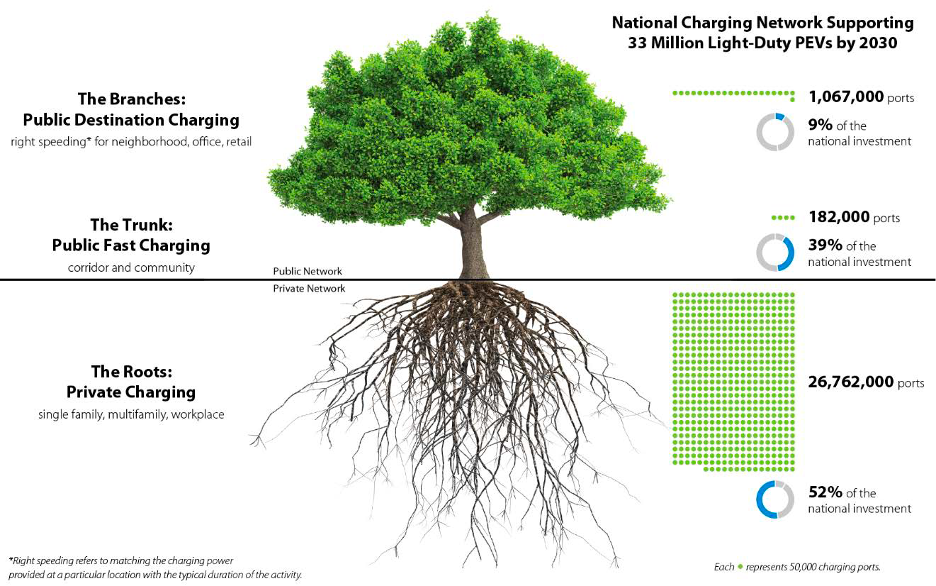The Joint Office of Energy and Transportation this week issued its first annual report of the National Electric Vehicle Infrastructure (NEVI) Formula Program, which will provide $5 billion in funding for a national network of high-speed EV charging stations.
Highlights include:
- All 50 states plus the District of Columbia and Puerto Rico submitted plans for investing the first $1.5 billion in funding;
- Most states have adequate funding to become “fully built out,” providing EV charging every 50 miles along 75,000 miles of designated alternative fuel corridors (AFCs); and
- Currently designated EV corridors comprise 33% of the National Highway System and 92% of the Interstate Highway System.
NEVI Key Attributes
- Minimum of four plugs (each of the four must be CCS format; NACS/Tesla permitted;
- Each plug must be capable of simultaneously dispensing energy at a rate of at least 150 kW;
- A distance of 50 miles between locations; and
- Chargers can be no more than one mile from the interstate.
NEVI funds may be used for the following:
- The acquisition and installation of EV charging infrastructure;
- Operations and maintenance (O&M) costs of EV charging infrastructure;
- Data sharing about EV charging infrastructure;
- Development phase activities related to acquisition and installation of stations;
- On-premises signage to provide information about EV charging infrastructure acquired and installed or operated;
- Traffic control devices in rights-of-way to provide directional information about EV charging infrastructure acquired and installed or operated; and
- Mapping and analytics activities to support the acquisition, installation, and operation of EV charging infrastructure under this program.
The Need for Infrastructure
The Joint Office and DOE’s Vehicle Technologies Office recently partnered to support the National Renewable Energy Laboratory’s development and publication of a report titled “The 2030 National Charging Network: Estimating U.S. Light-Duty Demand for Electric Vehicle Charging Infrastructure.” This report likened infrastructure to a tree, with the following key findings:
- Supporting a total of 33 million light-duty EVs, a mid-level adoption estimate, by 2030 will require over 28 million charging ports (both public and private) and cumulative investment between $53 and $127 billion. Approximately 1.2 million of the 28 million charging ports are publicly available in this analysis.
- Lower-power AC charging accounts for the majority of needed charging ports (approximately 26.8 million), while the estimated 182,000 needed DCFC stations could make up as much as 39 percent of the $53–$127-billion investment.
- The composition of the national public network is uncertain and will vary regionally, depending ultimately on vehicle adoption, access to residential charging, and individual charging preferences.
States are Taking Various Approaches
According to the Joint Office’s report, states are taking a variety of approaches to deploying NEVI funding. Some are prioritizing implementation of new NEVI-compliant stations along the AFCs before making upgrades to existing stations. Some states are proposing a combined approach, allowing for flexibility. Given that the states are in the early planning stages of their programs, the total number of proposed stations at the national level is not yet known. In nearly all plans, states proposed general station locations by exit, city/town, or a grouping of exits within a geographic zone. However, some states provided multiple candidate station locations within an identified gap in the network but did not explicitly state how many total stations would be required. Others listed several existing stations along AFCs that could potentially be upgraded to meet NEVI requirements but did not indicate the total number of stations that would need to be upgraded. Some states did not define station locations or numbers at all, leaving station siting up to future contract/grant awardees during implementation.

NEVI Background
The 2021 Bipartisan Infrastructure Bill, also known as the Infrastructure Investment and Jobs Act, authorized $7.5 billion in funding to states and other localities to strategically deploy EV charging infrastructure and establish an interconnected network to facilitate data collection, access, and reliability ($5 billion for NEVI and $2.5 billion for a discretionary community grant program, plus an additional $5.6 billion to support low- and no-emission transit bus deployments, and $5 billion to support electric school buses).
The law also established the Joint Office, an interagency collaboration between the U.S. Department of Energy and U.S. Department of Transportation. The Joint Office’s responsibilities (per the statute) include:
- Technical assistance;
- Data sharing of installation, maintenance, and utilization;
- A national and regionalized study of zero-emission vehicle charging and refueling infrastructure needs and deployment factors to support grants for community resilience and EV integration;
- Development and deployment of training and certification programs;
- Establishment and implementation of a program to promote renewable energy generation, storage, and grid integration, including microgrids, in transportation rights-of-way;
- Studying, planning, and funding for high-voltage infrastructure (including constructing pilots) in the rights-of-way of the Interstate Highway System;
- Research, strategies, and actions under the departments’ statutory authorities to reduce transportation-related emissions and mitigate the effects of climate change;
- Development of a streamlined utility accommodations policy for high-voltage and medium-voltage transmission in the transportation rights-of-way; and
- Any other issues that the Secretary of Transportation and Secretary of Energy identify as issues of joint interest.
For more information about EVs and EV charging, I invite you to follow me on LinkedIn and view my other posts.


